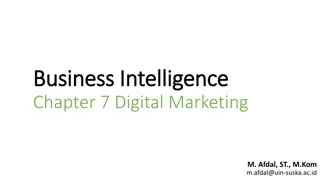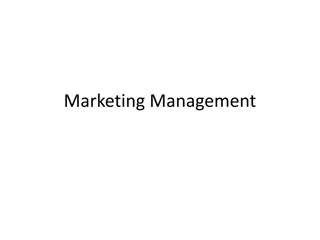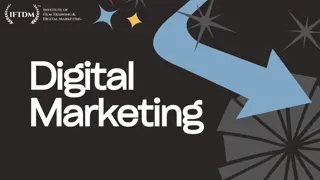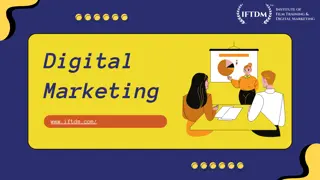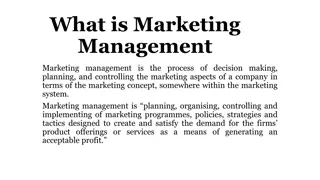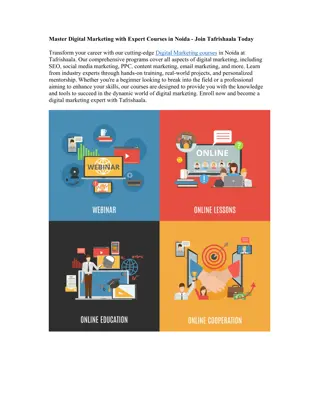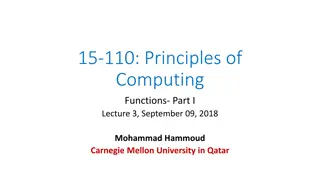Marketing Research Essentials: Concepts, Definitions, and Functions
Learn about the significance and functions of marketing research, understand the core concepts, definitions, and features of this crucial business activity. Discover how marketing research helps in making informed decisions and enhancing market intelligence.
Download Presentation

Please find below an Image/Link to download the presentation.
The content on the website is provided AS IS for your information and personal use only. It may not be sold, licensed, or shared on other websites without obtaining consent from the author.If you encounter any issues during the download, it is possible that the publisher has removed the file from their server.
You are allowed to download the files provided on this website for personal or commercial use, subject to the condition that they are used lawfully. All files are the property of their respective owners.
The content on the website is provided AS IS for your information and personal use only. It may not be sold, licensed, or shared on other websites without obtaining consent from the author.
E N D
Presentation Transcript
INTRODUCTION TO MARKETING RESEARCH
CONCEPT OF MARKETING RESEARCH According to Henry Mintzberg, a manager performs interpersonal, informational & decision making or disturbance handling roles. But in absence of exact accurate information, there are all the more chances to have taken a wrong decision. It takes years to get a customer and it takes second to lose one. In Second words of marketing research means gathering, recording, collecting, analyzing and interpreting the data collected are the activities done in marketing research.
Definitions: Marketing is the activity, set of institutions and process for creating that have value for customers, client, partners and society. The word Re in search suggests the continuity required for research effort, as market evolves, changes, discards, adopts, newer futures in the product offerings, answering customers choices is again a task of marketing research IMRB international, TNS India and Synovate India are some of the top market research companies.
Marketing wants precise answers & emerging trends on 1. Who ( The target customer ) 2. Why ( Features, decision process, role of influencers & information ) 3. What ( Product choices, elementof individuality & loyalty ) 4. Where ( Distribution channel made use of, impact of relations etc. ) 5. When ( Trends in purchase pattern seasonality, cyclicality, irregularity or festival impact of social events ) 6. How ( Choices of all four Ps )
FUNCTIONS OF MARKETING SEARCH. It enables getting information for effective decision making. It helps in preserving historical records and marketing knowledge. Managing research process in totality. Becoming light bearer in terms of market expenditure. Making market intelligence available to all the departments as a central resources. Ensuring research design to be in line with research objectives. Integrating research activities, so that all the departments can avail crucial relevant information
FEATURES OF MARKETINGRESEARCH Features of marketing research are as follows. Variety of methods. Art-Science Scientific basis of collection and individual ability or art in finding solutions. Applied research. A Package. Phases. Process cum tool. Fills and links the market gaps. Advantage : Company Consumer. Strategy or Trade Secret. No Auto mode Self corrections. New borne Wide acceptance. Systematic, Objective & accurate.
IMPORTANCE OF MARKETINGRESEARCH Large spending & inbuilt expectation of return on investment expenditure Confident step forward Meeting marketing objectives Helps in decision making Finding solution to marketing problems New markets or avenues Key questions get answered
SCOPE OF MARKETING RESEARCH Scope of marketing research is very wide & broad. Sales Research. Market Research. International Marketing Research. Product Research. Pricing Research. Distribution Research. Advertising Research.
Media Research ConsumerResearch PackagingResearch Motivationresearch Policy research
Sales Research: Data compared between inter-territorial zones & intra-territorial zones. Its shows change in tastes and preferences of customer. Survey of Sales people and future demand, change required in selling method etc. can be known through such research. o Marketresearch: A firm operates in a market environment which consist of competition. Different prices, strategies of competitor & result impact in sales etc. are assessed through market research. Sales territories, sales quotas and sales targets can be fixed with such research.
International Marketing research: Opportunity in one country may die down, whereas the same product in other country can be high demand. Environmental threats and opportunity profile can be created and SWOT analysis for entering various global markets can be prepared. The decision can be achieved through international marketing research by studying consumption patterns abroad, competition, consumers from foreign countries, governmental role and impact on sales, alliances or full fledged operations.
Product Research: It studies the impact of change in product design, colour, size, shape, quality, packaging, brand name, price sensitivity, accessories, attachments and price of product on sales. Innovation, modification, product life cycle based strategies, classification of products as per BCG matrix facilitated through product research. o PricingResearch: It is studies of pricing of product. It selects a suitable method of pricing. It fix the price of the product. It compares the company s product price with price of competitor's. It also fixes the discount & commission which are given to middlemen.
Distribution Research: It includes answers of questions such as 1. How the product reaches to the customer ? 2. Are there region wise prefers ? 3.Do they prefer to purchase products from retailer or do they go for online purchase or do they have any prefers for distributors ? Advertising Research: it is studies about advertising of the product. It fixes the advertising objectives. It also fixes the advertising budget. It decides about advertising message, layout, copy, slogan , headline etc. It selects a suitable media for advertising o
Media Research: In media research Ad. budget, campaigns, promotional strategies & its impact on sales is assessed of media like TV, Radio, Newspaper, Magazines, Internet etc. Media cost, media planning and sales promotional planning are facilitated with it. Effectiveness of media, timing of advertising are answered with this research. o Consumer Research: Consumer s needs changes in them cyclicality, seasonality, irregularity, like-dislike, awareness level, interest & desire in purchase action, purchasing attitude, impact of demographics like age, gender, income, location, buying motives etc.
Packaging Research: Ease, attractiveness, level of value creation, packaging cost and relevant packaging material gets decide due to packaging research. The packaging should be for better handling or storage. Customer prefers packaging for ease and its attractiveness. o Motivation Research: Buying motives, rationale behind buying influence and impact of sales promotion on sales is measured through marketing research. o Policy Research: marketing polices, inventory polices, sales policies, distribution policies, pricing policies etc allows a company to from streamlined policies
MARKETING RESEARCH PROCESS.
Data Collection Define the Problem. Data Processing Sample Respondents Primary Survey Analysis of Data Finalising Objective Drafting Preparing Questionnaire Research Report Presenting finding for decision, following Sourcing out Data Research Design
Define the problem: The first step in a marketing research process is to identify the problem or opportunity. The problem may be about decrease in sales, increase in competition, expansion of market, etc. Primary Survey: It makes a point to ask a question, whether the problem is an outcome or is it a cause. even if it being a cause its aggravation could be due to several other serve factors. Stopping at out comes does not help in digging out the exact problem or concerns. Finalising objective: After the survey, the researcher comes to know the cause behind the situation. In this stage its like a flow chart which is finding result of various causes and its varying level of impact leading to problem.
Sourcing out data: The researcher first collects secondary data. This is because it is easily available and less costly. It is collected by Desk Research. Desk Research can be internal for e.g. collected from company's records or external i.e. acquired from libraries, trade journals, government sources, etc. If the secondary data is not sufficient to solve the marketing problem, then primary data is wheeled. Collecting primary data is very costly and time consuming. It can be collected by using survey methods, i.e. by doing personal interviews, telephone interviews and mail surveys. It canalso be collected by using observational method and experimentation method.
Research Design: Research design is a plan for conducting a research. It guides the researcher in data collection. It gives proper direction to the research. Preparing Questionnaire: In this stage, primary data is collected with the help of a questionnaire. So the researcher has to prepare a questionnaire. A questionnaire is a list of questions. These questions are asked to the respondents for collecting data. The questionnaire must be suitable so that the require data is collected easily, quickly and correctly. It is used for conducting person interview, telephone interviews and mail survey. The researcher must decide about the type of the information required, the type of questioned to be asked, the wordings of the questionnaire, its order, etc.
Sample Respondents: Ensuring no lapses in structure or wording of questionnaire, a dry run or rehearsal is attempted. This stage is also known as pilot survey. Data Collection: Data can be collected such as mail survey method, with help of trained interviewers in case of personal interview method. Collected data should be reliable, magnifiable, sufficient & complete.
Data Processing: collected data is processed for drawing out larger picture. Classification of data, scrutiny of data, editing, coding etc are done in this stage. It is arrangement & processing of data for analysis. Analysis and interpretation of data: In this stage, the researcher analyzes and interprets the data. That is, he studies the data very careful and draws conclusions from it. These conclusions are then used to solve the marketing problem.
Drafting Research report: In this stage, the researcher prepares the final research report. This report contains a title of the report, method used, findings, conclusions and suggestions about how to solve the marketing problem. The language of the report must not be very difficult. The report must be submitted to the marketing executives for recommendations and implementation. o Presenting finding for decision, following: Finally, the last step in a marketing research process is to do a follow up. In this stage, the marketing executive makes changes in the product, price, marketing policies, etc. as per the recommendations of the report. Here, the researcher should find out, whether his recommendations are implemented properly or not. He should also figure-out, whether the marketing problem is solved or not.
LIMITATIONS OF MARKETING RESEARCH. Limitations of Marketing Research are as follows: No Auto mode or readymade solution. Not a one size fits all. Data dependent. Not Dynamic as the world out there is. Can avoid a risk, but not without a cost .
Not an effective prediction. Dependence on skilled researcher. Customers and competitors make the environment Applicability is the key. Old data = No data. Communication is Important Urban Rural disparity Back to square one
Managing Marketing Information Systems and Marketing Research
Why Small Businesses Need Marketing Information System? The advantages of having an effective information system are 1. Organized collection and storage of data in the Organization 2. Reduced information searching time and cost 3. Speed up obtaining relevant information sufficiently to make decisions 4. Ability to forecast future market status 5. Provides a competitive advent
What is an Information System (IS)? An information system is a set of interrelated components that collect, process, store and disseminate information to the parties who make decisions regarding the business.
Marketing Information System (MKIS) A marketing information system is a kind of information systemwhich gathers and stores data on marketing. A Marketing Information System (MKIS) is a collection of people, equipment's, and procedures to collect, sort, analyze, evaluate and distribute needed information in timely and accurate manner to the marketing decision makers (Kotler & Armstrong, 2013). This consist four steps. Access information needs Develop needed information Analyze information Distribute information for decision makers
Internal Records System In a small business organization, the records are kept about Orders sales prices of the products customercomplaints receivables the creditors. These records are called as internal records. from debtors and payable to These records can be maintained either manually or using computer data bases. Ex-:You may have seen small grocery shopsmaintain small invoice books as record of sales. That is one example for maintenance of an internal record in a small business.
Marketing Intelligence System Internal records system provides data for day today decision making. But a Marketing intelligence system provides predictive data relating to a particular situation. It is defined as a system which produces everyday informationaboutthe changes in the marketingenvironment. the sources of marketing intelligence system Newspapers Magazines trade publications talking tocustomers suppliers and distributors A small business organization can keep manual records of data generated through this type of system for effective decision making.
Marketing Decision Support Analysis The next component of MKIS is Marketing Decision Support Analysis . These are tools which can be used to analyze to make effective marketing decisions. Marketing decision support analysis tools include computer software like Geographic Information System (GIS) to track inventory details of the product dealers. Further, this includes statistical tools like time series sales modes, linear programming, elasticity models (price, incomes, demand, supply,etc.), spreadsheet 'what if models . These information help marketers to make decisions on market segmentation, pricing policies, budgeting, etc.
Marketing Research System The purpose of conducting a marketing research is to gather information regarding a specific marketing problem of the business. An organization can conduct research by using a research team in the outsourcing it to the research firm. organization itself or
Marketing Research Process Marketing research design, collection, analysis and reporting of data relevant to a specific marketing situation. is a process of systematic According to Kotler and Armstrong (2014) marketing research process has four steps which can be briefly discussed as follows. Defining the problem and researchobjectives Developing the research plan to collect information Implementing the research plan - collecting and analyzing thedata Interpreting and reporting the findings
01.Defining the problem and research objectives This is the first and most often the hardest step in the marketing research process. Most often the business owners may be aware that something is wrong, but they may fail to know the exact cause for the problem. Forexample, Would a 10 percent decrease in the price of a product result in attraction of more customers to offset the impact of pricereduction? Therefore, in such a situation the determination of research problem and objectives will guide the entire process. It is very important to identify the real problem apart from symptoms of the problem.
02.Developing the research plan to collect information This plan should basically outline the sources of information, contact methods, sampling methods and the tools that should be used to gather new data. When collecting information, businesses can refer both primary and secondary data sources. Primary data includes the information collected for a specific purpose at hand whereas. secondary data includes information that has been already collected for any other purpose. survey method, observation, interviewing customers, mystery shopping are the methods used to collect primary data. The secondary data can be collected via referring paper articles, magazines, data from department of census and statistics, central bank reports, trade journals, etc.
03.Implementing the research plan - collecting and analyzing the data This is the stage in which the research plan is actually put into action where the actual data collection and analysis would take pace. In this step the organizations will be able to uncover some of the problems that might have happened in the previous stage such as problems of interacting with the respondents, quality of participants responses, mistakes happened in the interviews etc. Accordingly, after analyzing the collected data the business owners will be able to identify and isolate important insights which will be helpful in decisionmaking.
04.Interpreting and reporting the findings Interpretation of the findings is an important but tricky task. This is mainly because the interpretation of the analysis will depend on a number of factors such as the knowledge of the interpreter regarding the subject and the accuracy and relevance of information. Thus, it is advisable to take the advice of the experts in interpreting the results and drawing conclusions based on them.
Obstacles of Maintaining an Effective Marketing Information System in a Small Business But maintaining an effective information system in a small-scale business is not an easy task due to many reasons. Lack of knowledge on importance of MKIS amongsmall business owners Lack of human resources to maintain an effective MKIS system Short term business focus . Lack of awareness on how to maintain a MKIS system.
Integrated Marketing Communications Personal selling Advertising Sales promotion Public relations Direct marketing BASIC ADAPTABLE 42
Setting the Promotion Mix Reach Many Buyers, Repeat Message Many Times, Impersonal, Expensive Reach Many Buyers, Repeat Message Many Times, Impersonal, Expensive Personal Interaction, Relationship Building, Most Expensive Promo Tool Wide Assortment of Tools, Rewards Quick Response, Efforts Short-Lived Very Believable, Dramatize a Company or Product, Underutilized Nonpublic, Immediate, Customized, Interactive Advertising Advertisin g Persona l Selling Sales Promotio n Public Relation s Direct Marketin g Personal Selling Sales Promotion Public Relations Direct Marketing Personal Interaction, Relationship Building, Most Expensive Promo Tool Wide Assortment of Tools, Rewards Quick Response, Efforts Short-Lived Very Believable, Dramatize a Company or Product, Underutilized Nonpublic, Immediate, Customized, Interactive 43
Factors in Setting Promotion Mix Buyer State Liking, Preferences, and Conviction Purchase Product-Life-Cycle Stage Introduction Growth Mature Decline 44
Advertising Advertising is Any Paid Form of Nonpersonal Presentation and Promotion of Ideas, Goods, or Services by an Identified Sponsor. 45
Advertising Its function is to inform consumers about product differences, new products and application possibilities. 46
Advertising It plays a role in the competitive process by firstly bringing differences in products or services to the attention of the consumer. Secondly, it persuades consumers to prefer on company s product to those of another. Thirdly, It creates value by its communication strategy. 47
Main Advertising Objectives Informative Advertising Persuasive Advertising Reminder Advertising 48
Characteristics of Advertising One way communication It deals with thousands of consumers and each one receives the same mesage. Depends on symbols: brand logos Low-cost mass communication Persuasive communication 49
Advertising media Newspapers Magazines Television Direct mail Radio Etc 50







